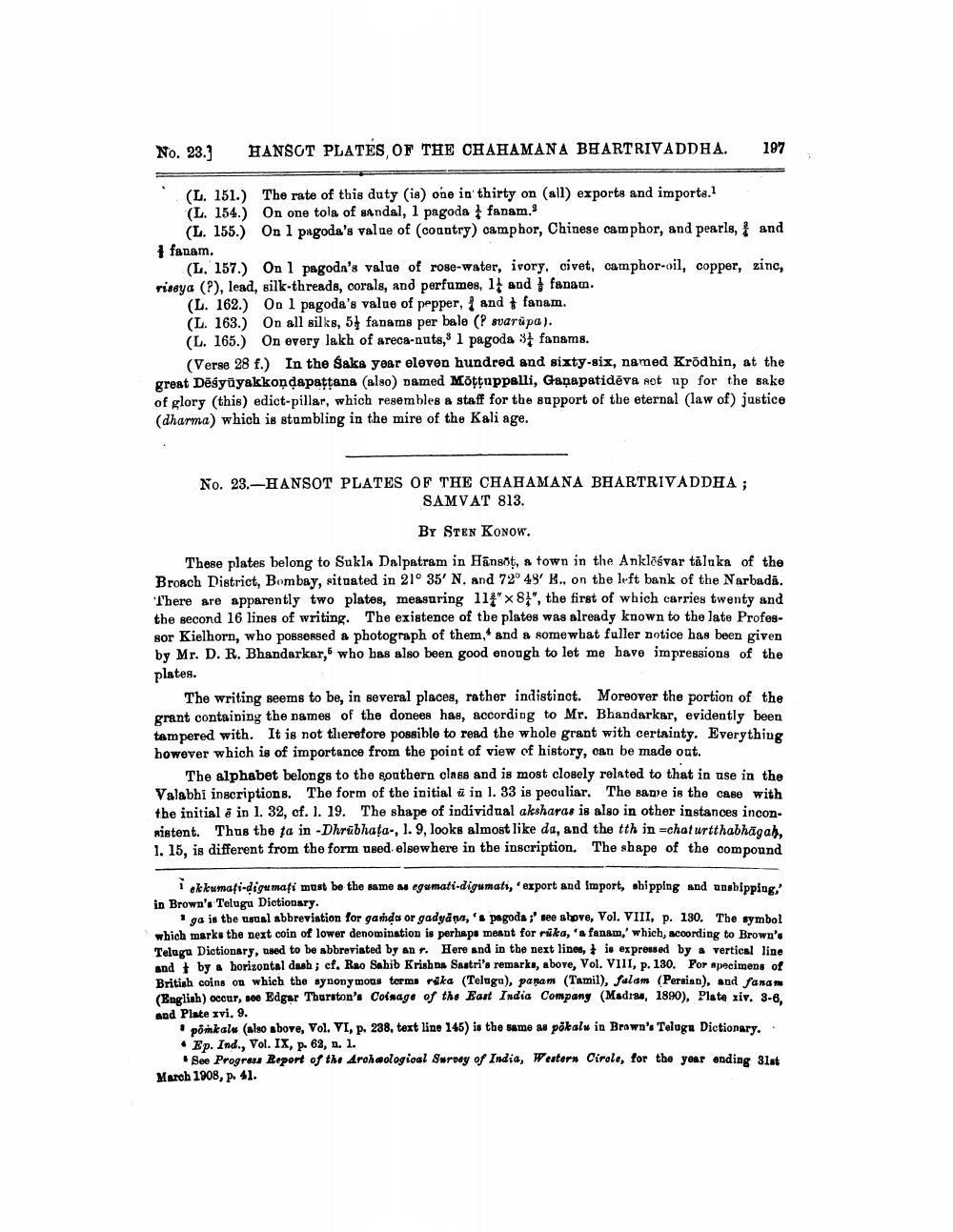________________
No. 23.
HANSGT PLATES OF THE CHAHAMANA BHARTRIVADDHA.
197
(L. 151.) The rate of this duty (is) one in thirty on (all) exports and imports. (L. 154.) On one tola of sandal, 1 pagoda fanam.
(L. 155.) On 1 pugoda's value of country) camphor, Chinese camphor, and pearls, and 1 fanam.
(L. 157.) On 1 pagoda's value of rose-water, ivory, civet, camphor-vil, copper, zinc, risaya (P), lead, silk-threads, corals, and perfumes, 11 and fanan.
(L. 162.) On 1 pagoda's value of pepper, and fanam. (L. 163.) On all silks, 51 fanams per bale (P svarüpa). (L. 165.) On every lakh of areca-nuts, 1 pagoda 34 fanams,
(Verse 28 f.) In the Saka year eleven hundred and sixty-six, named Krodhin, at the great Dēģyüyakkoņdapattana (also) named Mottuppalli, Ganapatidēva not up for the sake of glory (this) edict-pillar, which resembles a staff for the support of the eternal (law of) justice (dharma) which is stumbling in the mire of the Kali age.
No. 23.-HANSOT PLATES OF THE CHAHAMANA BHARTRIVADDHA ;
SAMVAT 813.
BY STEN KONOW.
These plates belong to Sukla Dalpatram in Hānsőt, a town in the Anklośvar taluka of the Broach District, Bombay, situated in 21° 35' N. and 72° 49' E., on the left bank of the Narbadā. There are apparently two plates, measuring 114' x 81', the first of which carries twenty and the second 16 lines of writing. The existence of the plates was already known to the late Professor Kielhorn, who possessed & photograph of them, and a somewhat fuller notice has been given by Mr. D. R. Bhandarkar, who has also been good enough to let me have impressions of the plates.
The writing seems to be, in several places, rather indistinct. Moreover the portion of the grant containing the names of the donees has, according to Mr. Bhandarkar, evidently been tampered with. It is not therefore possible to read the whole grant with certainty. Everything however which is of importance from the point of view of history, can be made out.
The alphabet belongs to the southern class and is most closely related to that in use in the Valabhi inscriptions. The form of the initial ü in l. 33 is peculiar. The same is the case with the initial & in l. 32, cf. 1. 19. The shape of individual aksharas is also in other instances inconsistent. Thus the fa in-Dhrubhata., 1. 9, looks almost like da, and the tth in -chaturtthabhāgah. 1. 15, is different from the form used elsewhere in the inscription. The shape of the compound
ekkumati-digumati must be the same megumati-digumati, export and import, shipping and unshipping," in Brown's Telugu Dictionary.
Iga in the usual abbreviation for ganda or gadyana, 'pagoda ;' see above, Vol. VIII, p. 130. The symbol which make the next coin of lower denomination is perhaps meant for rika, 'a fanam,' which, according to Brown's Telugu Dictionary, need to be abbreviated by an . Here and in the next lines, * is expreused by a vertical line and + by a horizontal dash; cf. Rao Sahib Krishna Sastri's remarks, above, Vol. VIII, p. 130. Por specimens of British coins on which the synonymous torms rika (Teluga), panam (Tamil), falam (Persian), and fanam (English) occur, se Edgar Thurston's Coinage of the East India Company (Madra, 1890), Plate xiv. 3-6, and Plate xvi. 9.
poikalu (also above, Vol. VI, p. 288, text line 145) is the same as pökalu in Brown's Telugu Dictionary. • Ep. Ind., Vol. IX, p. 62, n. 1.
See Progress Report of the Archeological Survey of India, Western Cirole, for the year ending 31st March 1908, p. 41.




